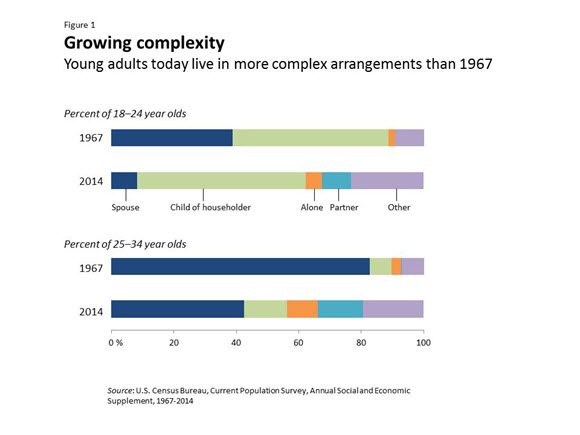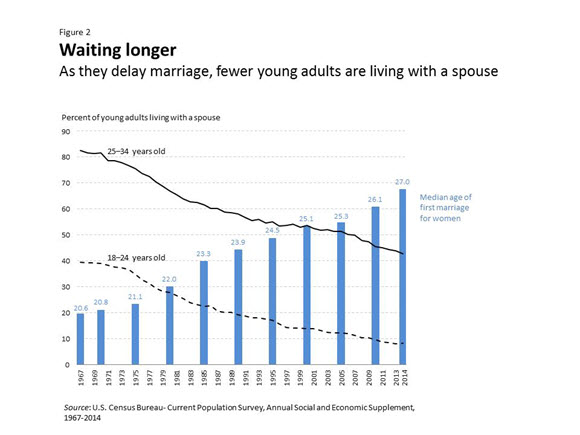
An official website of the United States government
Here’s how you know
Official websites use .gov
A .gov website belongs to an official government organization in the United States.
Secure .gov websites use HTTPS
A lock (
) or https:// means you’ve safely connected to the .gov website. Share sensitive information only on official, secure websites.
-
//
- Census.gov /
- Random Samplings /
- Singles, Mingles and Wedding Jingles: Partnerships and Living Arrangements from 1967 to 2014
Singles, Mingles and Wedding Jingles: Partnerships and Living Arrangements from 1967 to 2014
Singles, Mingles and Wedding Jingles: Partnerships and Living Arrangements from 1967 to 2014
In 1967, almost nine in 10 young adults were living in just two arrangements, either with a parent or with a spouse. While about half of 18- to 24-year-olds still live with a parent today, the other half live in more diverse arrangements. Among young adults between the ages of 25 and 34, the majority no longer live with a spouse but with a partner, alone or with others (see Figure 1). Living with others includes living with relatives other than a parent (such as a child) or nonrelatives.
The biggest change in living arrangements since 1967 is related to the delay in marriage. On average, young adults wait nearly six years longer [XLS <1.0 MB] to get married today than in 1967. Marrying later is part of the reason why the 25- to 34-year-olds of 2014 resemble the 18- to 24-year-olds of 1967 in terms of percentage living with a spouse (see Figure 1). For example, 39 percent of 18- to 24-year-olds lived with a spouse in 1967, similar to the 43 percent of 25- to 34-year-olds in 2014. Today, only 8 percent of 18- to 24-year-olds live with a spouse.
We now have cohabitation estimates dating back to 1967. While a direct measure for cohabitation is not available, we created an estimate based on adults who lived with an opposite-sex adult nonrelative. The proportion of 18- to 24-year-olds living with an unmarried partner is about nine times higher today than in the 1970s and about 15 times higher for 25– to 34–year–olds. Cohabitation has become so widespread that women now have about a 75 percent chance of living with a partner [PDF <1.0 MB] before marriage by age 30.
Over the last 50 years, the proportion of 25- to 29-year-olds with a college degree has more than doubled [XLS <1.0 MB], from about 15 percent to 34 percent. Young adults are also delaying childbearing but are not necessarily waiting for marriage to have children. Only 60 percent [XLS <1.0 MB] of young adult parents live with a spouse. The remaining 40 percent are single parents. This is one reason we see an increase over time in young adults living with other relatives, because single parents are counted in this category.
While young adults are delaying marriage, research shows they are choosing to live alone, with others or with an unmarried partner while they pursue higher education, seek stable employment and form families. Adults under the age of 35 today are living in a wider variety of living arrangements than what has been the norm in decades past. To see the changes for all age groups, please visit the Families and Living Arrangements website.
Share
 Yes
Yes
 No
NoComments or suggestions?


Top


